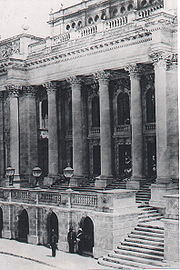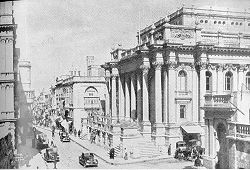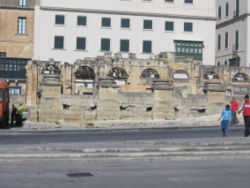
Royal Opera House, Valletta
Encyclopedia
The Valletta Royal Opera House was an opera house
and performing arts venue in Valletta
, Malta
. It was designed by English
architect
Edward Middleton Barry
and was erected in 1866. In 1873 its interior was extensively damaged by fire but was eventually restored by 1877. The theatre was bombed to the ground during World War II
in 1942.
, the architect of Covent Garden Theatre. The original plans had to be altered because the sloping streets on the sides of the theatre hadn’t been taken into consideration. This resulted in a terrace being added on the side of Strada Reale (Republic Street).
The building of the 206 feet (62.8 m) by 112 feet (34.1 m) site started in 1862, after what was the Casa della Giornata was demolished. After four years, the Opera House, with a seating capacity of 1095 and 200 standing, was ready for the official opening on October 9, 1866.
The theatre was not to last long; on May 25, 1873, a mere six years after its opening, it was brought to a premature end by a fire. The exterior of the theatre was undamaged but the interior stonework was calcified by the intense heat.
 It was decided to rebuild the theatre, and after the issuing of tenders for the work and a lot of arguing whether the front had to be changed or not, the theatre was ready. On October 11, 1877, after nearly four and a half years from the fire, the theatre reopened with a performance of Verdi
It was decided to rebuild the theatre, and after the issuing of tenders for the work and a lot of arguing whether the front had to be changed or not, the theatre was ready. On October 11, 1877, after nearly four and a half years from the fire, the theatre reopened with a performance of Verdi
's Aida
.
Some 65 years later, tragedy struck the Royal Opera House again:
The remaining structures were levelled down as a safety precaution. There is a claim that German prisoners-of-war
in Malta offered to rebuild the theatre in 1946 with the Government declining due to Union
pressure; the more likely reason—if the offer was ever made—was that hardly anyone of these prisoners of war could be expected to be qualified masons.

In 1953, six renowned architects submitted designs for the new theatre. The Committee chose Zavellani-Rossi's project and recommended its acceptance by Government subject to certain alterations. The project ground to a halt on Labour
's re-election, contending that it was not in a position to spend so much money on a theatre when so many other projects needed attention. Although a provision of 280,000 pounds
for the reconstruction of the theatre had been made in the 1955-56 budget, these were never used. By 1957 the project had been shelved and after 1961 all references to the theatre in the country's development plans were omitted.
 In the 1980s contact was made with renowned architect Renzo Piano
In the 1980s contact was made with renowned architect Renzo Piano
to design a building to be constructed on site as well as the rehabilitiation of the entrance of the city. Piano
submitted the plans which were approved by the Government in 1990 but work never started probably through the controversies the plans generated. In 1996 the incoming Labour Government announced that reconstruction of the site into a commercial and cultural complex together with an underground car park would be Malta's millennium project. In the late 1990s Maltese architect Richard England was also commissioned to come up with plans for a cultural centre. Each time, controversies killed off all initiatives.
In 2006 the government announced a proposal to redevelop the site for a dedicated House of Parliament, presently located in the former Armoury of the Magisterial (Grand Master's) Palace in Valletta
. The proposal was not well received since it had always been assumed that the site would eventually developed into something that would house a cultural institution. The proposal was shelved until after the general elections of 2008
and on 1 December 2008, Prime Minister Lawrence Gonzi
revived the proposal with a budget of €80 million, once more, turning to Renzo Piano
for designs. Piano dissuaded the Government from building a Parliament on site of the Opera House (alternatively, he planned for a House of Parliament on present-day Freedom Square and a re-modelling of the city gate). Piano proposed an open-air theatre for the site citing the following rationale:
Typically, the plans for all three developments have caused controversy. The government, however, is going ahead with the plans.
Opera house
An opera house is a theatre building used for opera performances that consists of a stage, an orchestra pit, audience seating, and backstage facilities for costumes and set building...
and performing arts venue in Valletta
Valletta
Valletta is the capital of Malta, colloquially known as Il-Belt in Maltese. It is located in the central-eastern portion of the island of Malta, and the historical city has a population of 6,098. The name "Valletta" is traditionally reserved for the historic walled citadel that serves as Malta's...
, Malta
Malta
Malta , officially known as the Republic of Malta , is a Southern European country consisting of an archipelago situated in the centre of the Mediterranean, south of Sicily, east of Tunisia and north of Libya, with Gibraltar to the west and Alexandria to the east.Malta covers just over in...
. It was designed by English
England
England is a country that is part of the United Kingdom. It shares land borders with Scotland to the north and Wales to the west; the Irish Sea is to the north west, the Celtic Sea to the south west, with the North Sea to the east and the English Channel to the south separating it from continental...
architect
Architect
An architect is a person trained in the planning, design and oversight of the construction of buildings. To practice architecture means to offer or render services in connection with the design and construction of a building, or group of buildings and the space within the site surrounding the...
Edward Middleton Barry
Edward Middleton Barry
Edward Middleton Barry was an English architect of the 19th century.-Biography:Edward Barry was the third son of Sir Charles Barry, born in his father's house, 27 Foley Place, London. In infancy he was delicate, and was placed under the care of a confidential servant at Blackheath...
and was erected in 1866. In 1873 its interior was extensively damaged by fire but was eventually restored by 1877. The theatre was bombed to the ground during World War II
World War II
World War II, or the Second World War , was a global conflict lasting from 1939 to 1945, involving most of the world's nations—including all of the great powers—eventually forming two opposing military alliances: the Allies and the Axis...
in 1942.
History
The design of the building was entrusted to Edward Middleton BarryEdward Middleton Barry
Edward Middleton Barry was an English architect of the 19th century.-Biography:Edward Barry was the third son of Sir Charles Barry, born in his father's house, 27 Foley Place, London. In infancy he was delicate, and was placed under the care of a confidential servant at Blackheath...
, the architect of Covent Garden Theatre. The original plans had to be altered because the sloping streets on the sides of the theatre hadn’t been taken into consideration. This resulted in a terrace being added on the side of Strada Reale (Republic Street).
The building of the 206 feet (62.8 m) by 112 feet (34.1 m) site started in 1862, after what was the Casa della Giornata was demolished. After four years, the Opera House, with a seating capacity of 1095 and 200 standing, was ready for the official opening on October 9, 1866.
The theatre was not to last long; on May 25, 1873, a mere six years after its opening, it was brought to a premature end by a fire. The exterior of the theatre was undamaged but the interior stonework was calcified by the intense heat.

Giuseppe Verdi
Giuseppe Fortunino Francesco Verdi was an Italian Romantic composer, mainly of opera. He was one of the most influential composers of the 19th century...
's Aida
Aida
Aida sometimes spelled Aïda, is an opera in four acts by Giuseppe Verdi to an Italian libretto by Antonio Ghislanzoni, based on a scenario written by French Egyptologist Auguste Mariette...
.
Some 65 years later, tragedy struck the Royal Opera House again:
"On the evening of Tuesday, April 7, 1942 the theatre was devastated by LuftwaffeLuftwaffeLuftwaffe is a generic German term for an air force. It is also the official name for two of the four historic German air forces, the Wehrmacht air arm founded in 1935 and disbanded in 1946; and the current Bundeswehr air arm founded in 1956....
bombers. The next morning a people hardened by aerial bombing inspected the remains of their national theatre.... The porticoPorticoA portico is a porch leading to the entrance of a building, or extended as a colonnade, with a roof structure over a walkway, supported by columns or enclosed by walls...
and the auditorium were a heap of stones, the roof a gaping hole of twisted girders. The rear end starting half way from the colonnadeColonnadeIn classical architecture, a colonnade denotes a long sequence of columns joined by their entablature, often free-standing, or part of a building....
was however intact.
The remaining structures were levelled down as a safety precaution. There is a claim that German prisoners-of-war
Prisoner of war
A prisoner of war or enemy prisoner of war is a person, whether civilian or combatant, who is held in custody by an enemy power during or immediately after an armed conflict...
in Malta offered to rebuild the theatre in 1946 with the Government declining due to Union
Trade union
A trade union, trades union or labor union is an organization of workers that have banded together to achieve common goals such as better working conditions. The trade union, through its leadership, bargains with the employer on behalf of union members and negotiates labour contracts with...
pressure; the more likely reason—if the offer was ever made—was that hardly anyone of these prisoners of war could be expected to be qualified masons.

Reconstruction plans
Although the bombed site was cleared of much of the rubble and all of the remaining decorative sculpture, rebuilding was repeatedly postponed by successive post-War governments, in favour of reconstruction projects that were deemed to be more pressing.In 1953, six renowned architects submitted designs for the new theatre. The Committee chose Zavellani-Rossi's project and recommended its acceptance by Government subject to certain alterations. The project ground to a halt on Labour
Malta Labour Party
The Labour Party is, along with the Nationalist Party, one of two major contemporary political parties in Malta. It is the party of opposition in the Maltese House of Representatives where it has thirty-four of the sixty-nine seats.- Party Structure :...
's re-election, contending that it was not in a position to spend so much money on a theatre when so many other projects needed attention. Although a provision of 280,000 pounds
Maltese lira
The lira was the currency of Malta from 1972 until 31 December 2007. The lira was abbreviated as Lm, although the traditional ₤ sign was often used locally...
for the reconstruction of the theatre had been made in the 1955-56 budget, these were never used. By 1957 the project had been shelved and after 1961 all references to the theatre in the country's development plans were omitted.

Renzo Piano
Renzo Piano is an Italian architect. He is the recipient of the Pritzker Architecture Prize, AIA Gold Medal, Kyoto Prize and the Sonning Prize...
to design a building to be constructed on site as well as the rehabilitiation of the entrance of the city. Piano
Renzo Piano
Renzo Piano is an Italian architect. He is the recipient of the Pritzker Architecture Prize, AIA Gold Medal, Kyoto Prize and the Sonning Prize...
submitted the plans which were approved by the Government in 1990 but work never started probably through the controversies the plans generated. In 1996 the incoming Labour Government announced that reconstruction of the site into a commercial and cultural complex together with an underground car park would be Malta's millennium project. In the late 1990s Maltese architect Richard England was also commissioned to come up with plans for a cultural centre. Each time, controversies killed off all initiatives.
In 2006 the government announced a proposal to redevelop the site for a dedicated House of Parliament, presently located in the former Armoury of the Magisterial (Grand Master's) Palace in Valletta
Valletta
Valletta is the capital of Malta, colloquially known as Il-Belt in Maltese. It is located in the central-eastern portion of the island of Malta, and the historical city has a population of 6,098. The name "Valletta" is traditionally reserved for the historic walled citadel that serves as Malta's...
. The proposal was not well received since it had always been assumed that the site would eventually developed into something that would house a cultural institution. The proposal was shelved until after the general elections of 2008
Maltese general election, 2008
The latest Maltese general election for the renewal of the House of Representatives of Malta was held on March 8, 2008. The incumbent ruling party the Christian democratic Nationalist Party, led by Prime Minister Lawrence Gonzi, narrowly won over the social democratic Malta Labour Party led by...
and on 1 December 2008, Prime Minister Lawrence Gonzi
Lawrence Gonzi
Lawrence Gonzi is a Maltese politician who has been Prime Minister of Malta since 2004. He was Speaker of the House of Representatives of Malta from 1988 to 1996, Minister of Social Policy from 1998 to 1999, and Deputy Prime Minister from 1999 to 2004...
revived the proposal with a budget of €80 million, once more, turning to Renzo Piano
Renzo Piano
Renzo Piano is an Italian architect. He is the recipient of the Pritzker Architecture Prize, AIA Gold Medal, Kyoto Prize and the Sonning Prize...
for designs. Piano dissuaded the Government from building a Parliament on site of the Opera House (alternatively, he planned for a House of Parliament on present-day Freedom Square and a re-modelling of the city gate). Piano proposed an open-air theatre for the site citing the following rationale:
First, the site is too small to contain a Parliament Building as was initially envisaged. Secondly, a modern opera, of conventional size, would equally not fit in this place considering today’s requirements for rehearsal, back stage facilities and accessibility, besides generating exorbitant running costs. Thirdly, we strongly believe, that after more than 60 years of controversy, the Ruins of the demolished opera have undeniably reached the status of monument, irrevocable witness of history and the dignity of collective memory.
Typically, the plans for all three developments have caused controversy. The government, however, is going ahead with the plans.

